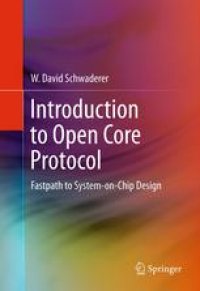
Ebook: Introduction to Open Core Protocol: Fastpath to System-on-Chip Design
Author: W David Schwaderer (auth.)
- Tags: Circuits and Systems, Electronics and Microelectronics Instrumentation, Processor Architectures
- Year: 2012
- Publisher: Springer-Verlag New York
- Edition: 1
- Language: English
- pdf
This book introduces Open Core Protocol (OCP) not as a conventional hardware communications protocol but as a meta-protocol: a means for describing and capturing the communications requirements of an IP core, and mapping them to a specific set of signals with known semantics. Readers will learn the capabilities of OCP as a semiconductor hardware interface specification that allows different System-On-Chip (SoC) cores to communicate. The OCP methodology presented enables intellectual property designers to design core interfaces in standard ways. This facilitates reusing OCP-compliant cores across multiple SoC designs which, in turn, drastically reduces design times, support costs, and overall cost for electronics/SoCs.
This book introduces Open Core Protocol (OCP), not as a conventional hardware communications protocol but as a meta-protocol: a means for describing and capturing the communications requirements of an IP core, and mapping them to a specific set of signals with known semantics. Readers will learn the capabilities of OCP as a semiconductor hardware interface specification that allows different System-On-Chip (SoC) cores to communicate. The OCP methodology presented enables intellectual property designers to design core interfaces in standard ways. This facilitates reusing OCP-compliant cores across multiple SoC designs which, in turn, drastically reduces design times, support costs, and overall cost for electronics/SoCs.
- Provides a comprehensive introduction to Open Core Protocol, which is more accessible than the full specification;
- Designed as a hands-on, how-to guide to semiconductor design;
- Includes numerous, real “usage examples” which are not available in the full specification;
- Integrates coverage of design methodology discussing why cores are structured the way they are, whereas the official OCP specification only answers what the structure is.
This book introduces Open Core Protocol (OCP), not as a conventional hardware communications protocol but as a meta-protocol: a means for describing and capturing the communications requirements of an IP core, and mapping them to a specific set of signals with known semantics. Readers will learn the capabilities of OCP as a semiconductor hardware interface specification that allows different System-On-Chip (SoC) cores to communicate. The OCP methodology presented enables intellectual property designers to design core interfaces in standard ways. This facilitates reusing OCP-compliant cores across multiple SoC designs which, in turn, drastically reduces design times, support costs, and overall cost for electronics/SoCs.
- Provides a comprehensive introduction to Open Core Protocol, which is more accessible than the full specification;
- Designed as a hands-on, how-to guide to semiconductor design;
- Includes numerous, real “usage examples” which are not available in the full specification;
- Integrates coverage of design methodology discussing why cores are structured the way they are, whereas the official OCP specification only answers what the structure is.
Content:
Front Matter....Pages i-xv
In the Beginning…There Were No Standards....Pages 1-12
OCP Training Wheels....Pages 13-19
OCP Write Operations....Pages 21-27
OCP Signals and Signal Groupings....Pages 29-36
Basic Signal Burst Extensions....Pages 37-51
Read Timing Diagrams....Pages 53-69
OCP Tags, Threads, and Connections....Pages 71-83
OCP Signal Groups and Phases....Pages 85-96
OCP Coherence Extensions: Theory of Operation....Pages 97-115
OCP Coherence Extensions: Signals and Encodings....Pages 117-140
OCP Coherence Extensions Timing Diagrams....Pages 141-149
Benchmarking Network-on-Chip (NoC) Designs....Pages 151-159
Back Matter....Pages 161-164
This book introduces Open Core Protocol (OCP), not as a conventional hardware communications protocol but as a meta-protocol: a means for describing and capturing the communications requirements of an IP core, and mapping them to a specific set of signals with known semantics. Readers will learn the capabilities of OCP as a semiconductor hardware interface specification that allows different System-On-Chip (SoC) cores to communicate. The OCP methodology presented enables intellectual property designers to design core interfaces in standard ways. This facilitates reusing OCP-compliant cores across multiple SoC designs which, in turn, drastically reduces design times, support costs, and overall cost for electronics/SoCs.
- Provides a comprehensive introduction to Open Core Protocol, which is more accessible than the full specification;
- Designed as a hands-on, how-to guide to semiconductor design;
- Includes numerous, real “usage examples” which are not available in the full specification;
- Integrates coverage of design methodology discussing why cores are structured the way they are, whereas the official OCP specification only answers what the structure is.
Content:
Front Matter....Pages i-xv
In the Beginning…There Were No Standards....Pages 1-12
OCP Training Wheels....Pages 13-19
OCP Write Operations....Pages 21-27
OCP Signals and Signal Groupings....Pages 29-36
Basic Signal Burst Extensions....Pages 37-51
Read Timing Diagrams....Pages 53-69
OCP Tags, Threads, and Connections....Pages 71-83
OCP Signal Groups and Phases....Pages 85-96
OCP Coherence Extensions: Theory of Operation....Pages 97-115
OCP Coherence Extensions: Signals and Encodings....Pages 117-140
OCP Coherence Extensions Timing Diagrams....Pages 141-149
Benchmarking Network-on-Chip (NoC) Designs....Pages 151-159
Back Matter....Pages 161-164
....